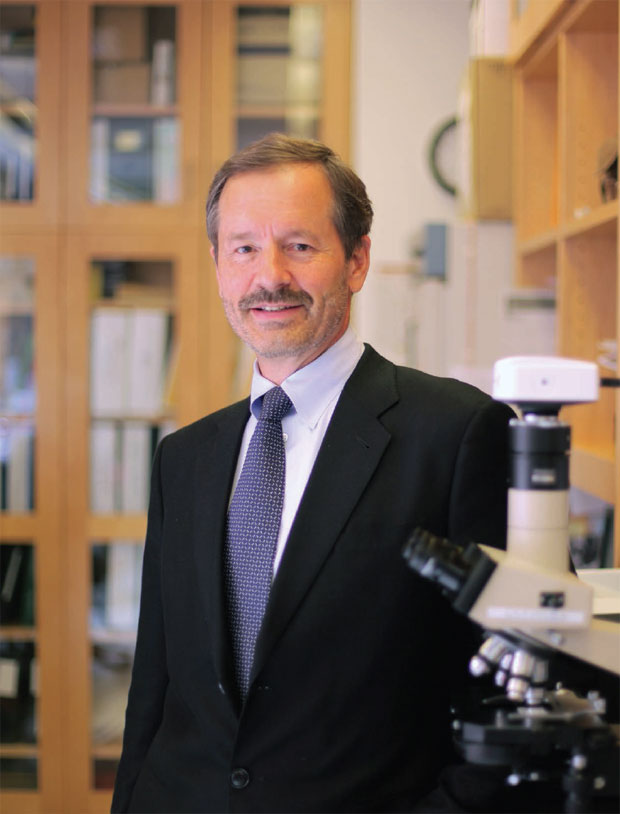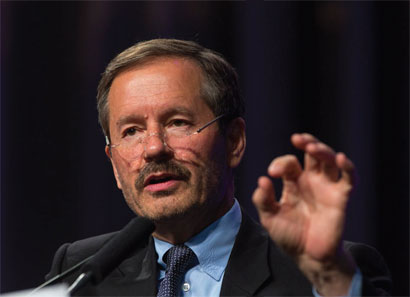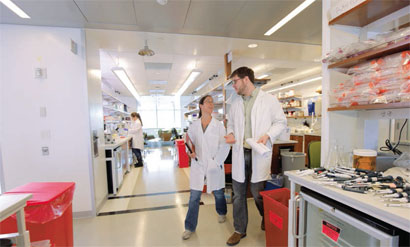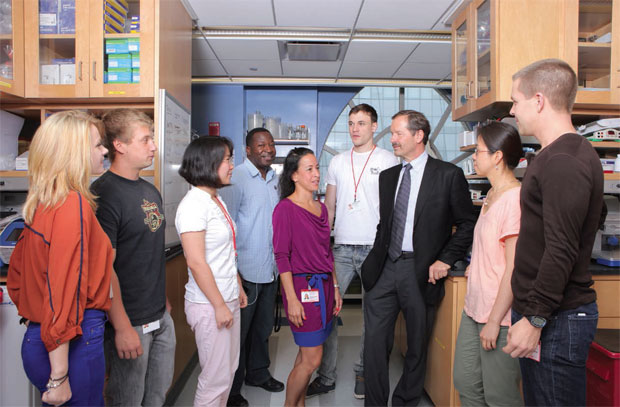
$3 million man: Lewis Cantley, PhD ’75, won the world’s most lucrative research prize in the life sciences. Photos: John Abbott.
When Lewis Cantley was a boy growing up in West Virginia, he once asked his father if they could buy some fireworks for the Fourth of July. “Why do you want to buy firecrackers?” his father responded. “Go make your own.” The senior Cantley gave his son the recipe for gunpowder, and young Lew went to work; before long, he’d graduated to building rockets. Similarly, Cantley’s go-kart was a custom design, powered by a souped-up lawnmower engine—which the boy optimized after studying the vagaries of internal combustion. “From my earliest memories,” says Cantley, PhD ’75, “I was always extremely curious about how everything worked.”
Cantley’s father was largely self-educated. He didn’t go to college, but he soaked up knowledge on a wide variety of topics, even reading the encyclopedia from A to Z. “He was in the Coast Guard during World War II, so he learned Morse code, which he taught me when I was quite young,” recalls Cantley, now a professor of cancer biology at the Medical College. “He also learned a lot about navigation, the tides, what controlled the weather. So when I would ask a question like ‘Why does it rain?’ instead of saying, ‘Because God makes it rain,’ he would say, ‘Well, the moisture collects, it rises, gets to a high temperature, cools in the high atmosphere, causes drops of a certain size, and at some point the drops become so large that they begin to fall.’ ”
The family never bought toys. If Cantley admired a plaything that a kid down the street had, his father would show him how to build it—and the boy would pass the knowledge on to his friends. “By the time I was sixteen I could take a car engine completely apart and put it back together, and it would run,” he says. “So that curiosity, and the confidence that I could figure out how anything worked, was what drove me. It also made me totally unafraid to ask questions about anything, because I figured I could understand it at some level.”

Spreading the word: Cantley describes the role of PI3K during a 2012 breast cancer symposium in San Antonio, Texas.
That mindset has served Cantley well over the past four decades. He’s now one of the world’s leading cancer researchers: the discoverer of a key pathway in cancer biology; leader of a $15 million Stand Up To Cancer “dream team”; winner of the most lucrative prize in biology and medicine. His recruitment from Harvard in fall 2012 was both a coup for Cornell and a vital step in the buildup of its bench-to-bedside research enterprise. “It was a huge splash around the country,” Medical College Dean Laurie Glimcher says of Cantley’s hiring. “I knew it was a great recruit, but I did not anticipate what a buzz would be created. It immediately raised the image of both Weill Cornell and NewYork-Presbyterian Hospital.” John Leonard, associate dean for clinical research, lauds Cantley as not only a world-class scientist, but one who is intensely committed to bringing discoveries to the bedside. “It’s remarkable how patient-focused he is,” says Leonard, a professor of hematology and medical oncology. “Many people would be content to continue to write papers, win grants, and get acclaim, but he is focused on taking it to the next level—and always with an eye toward, ‘How are we ultimately going to use this to help patients?’ ”
For Cantley, the move offered not only the chance to get in on the ground floor of Weill Cornell’s institutional revolution—a shift symbolized by the $650 million Belfer Research Building, which opened in January with his lab as its first occupant—but the opportunity to work in an intensely collaborative environment at a propitious moment: the dawn of truly personalized medicine. “Over the years, there has been a very fragmented approach to cancer,” Cantley observes. “You have the basic scientists who know the pathways and understand the biology, the clinicians who treat the patients, and the pharma companies who make the drugs—and they’re three completely isolated groups of people. We have to bring them all together as a team. So when you design a clinical trial, you have the basic scientists suggesting the biomarkers; you have a mechanism teasing out the mutations in each individual patient; and then, based on that, you put the patient on the right trial. This needs to be done in a seamless manner. And it’s not done in a seamless manner anywhere—but the opportunity to do that here is better than at any other institution I know of.”
Cantley’s arrival roughly coincided with the founding of the Institute for Precision Medicine, a translational research hub the Medical College launched in early 2013 to offer targeted treatments based on a patient’s genetic profile—including those whose disease is advanced or has become drug resistant. Among the key targets in personalized cancer medicine is an enzyme whose discovery established Cantley’s scientific reputation two decades ago. Known as phosphoinositide 3-kinase (shortened as PI3-kinase or PI3K), it’s a signaling pathway that plays an essential role in as many as 80 percent of cancers, including those of the breast, ovaries, and endometrium. “In addition to discovering the enzyme and its function, Dr. Cantley has been involved in figuring out which types of tumors commonly contain mutations of the gene that encodes PI3-kinase, and he is now developing clinical trials whereby individuals that have this type of mutation can be treated with PI3-kinase inhibitors,” notes medicine professor Andrew Dannenberg, who has done extensive research on the connection between cancer and inflammation. “That’s a remarkable odyssey and body of work—from discovering the gene to understanding its function to figuring out how it’s regulated and what it controls downstream, all the way to determining its role in cancer and how often it’s mutated, and providing the basis for personalized cancer investigation.”
The PI3K pathway was the focus of the Stand Up To Cancer team that Cantley led, a sixty-researcher effort that wrapped up last October after four years. The work was also cited in the awarding of the first Breakthrough Prize in Life Sciences in February 2013. Cantley was one of eleven recipients of the prize, whose sponsors include founders of Google and Facebook—and which carries a $3 million award for each winner. That eye-popping amount (more than double that of the Nobel) initially prompted Cantley’s wife to ask, “Are you sure this isn’t a joke?” But no: the $3 million was indeed received—on his sixty-fourth birthday, no less.
Cantley was the second in a family of four children—Linda, Lew, Larry, and Lloyd—and the eldest boy. Their father worked for Union Carbide; their mother started college when Cantley was eleven and his youngest brother just three. The kids, who would all become straight-A students, helped her study. Surprisingly, the future cancer researcher never took a biology course after high school. “I was really interested in chemistry, physics, and math,” he says with a laugh, “probably from working with gunpowder and trying to figure out how to make my rocket get off the ground.”
He majored in chemistry at West Virginia Wesleyan College, graduating summa cum laude; on the Hill, he earned a PhD in physical biochemistry with a minor in theoretical physics. Eventually, his work led to investigations in metabolism and cell regulation. “I was interested in photosynthesis, how to capture light and convert that into fixing carbon or making ATP [a cellular fuel supplier], generating energy,” he recalls. “Asking those simple questions—which turned out not to be that simple—got me deeper and deeper into biology. And as I got interested in how cells regulate metabolism, that got me interested in cancer, because cancer cells are professionals at doing this. In fact it’s the ability to do this that makes them cancer cells.”

Science central: Cantley’s lab was the first to move into the Belfer Research Building.
When Cantley first identified PI3K in 1984, he didn’t realize he’d discovered something revolutionary—that it was a key player in transforming normal cells into cancerous ones. His “eureka” moment didn’t come until 1988, when an experiment revealed that PI3K was pointing the way to a whole new field. “I went home that night and said, ‘This is going to completely revolutionize cancer,’ ” he recalls. “To physicists, this would be like finding a quark no one had ever seen before.” But at the time, Cantley was something of a voice in the wilderness. Other researchers didn’t find his results credible, and he couldn’t get funding to pursue the findings. His reaction to the naysayers—including one luminary who pledged to eat his hat if it were true? “I ignored them,” he says. “I knew it was right. In some ways it doesn’t matter what other people believe, as long as you know it’s right. And I had other sources of money; it was only one of ten things I was doing in the lab. But I could not get a grant to fund this. So I siphoned off money from other things, because I knew this was far more important, and that people would eventually understand it.”
The story exemplifies one of Cantley’s firmly held beliefs: don’t assume that the received wisdom is complete, or even necessarily correct. “What we know about biology is about 5 percent of what actually goes on in biology,” he observes. “People read huge volumes of medical textbooks and so forth and say, ‘Everything is already understood; my job is just to memorize it, to dot the I’s and cross the T’s on what other people have done.’ That’s not at all the case. We’re at this time in biology where, in five or ten years, we’re going to be shocked at the complexity of things we never appreciated.”
A prime example: Once upon a time, physicians and scientists assumed that all cancers were more or less the same. These days, they know that nothing could be further from the truth; breast cancer alone has multiple subtypes, each requiring a different therapy. “We’ll be breaking cancers into smaller and smaller subgroups,” Cantley says. “Maybe only 5 percent of breast cancer patients will have a particular type—but if we have a drug that works for those 5 percent, and the next year we get another 5 percent, and the next year another 5 percent, in twenty years that adds up to a lot of people. That’s how we’re going to make progress. The problem we had in the past was that pharmaceutical companies weren’t interested in making a drug that didn’t work for everybody; at least it had to work for all breast cancer patients, all lung cancer patients, or all colorectal cancer patients. With that attitude, they failed over and over and over.”

Next generation: Cantley with members of his lab.
It’s increasingly accepted that close collaboration across disciplines—breaking down the traditional silo approach to research—is essential to tackling any complex scientific problem in today’s hyper-specialized, tech-driven world. And indeed, when Cantley is asked what kind of atmosphere he aims to foster in his lab, a spirit of collaboration is at the top of the list. “Biology is complicated,” he says. “Diseases are complicated. And the technologies you have to use to solve important questions are complicated.” For example, a single journal article could entail expertise from a variety of fields—describing the structure of a molecule, offering proof that a gene that encodes it is implicated in a particular disease, chronicling the effects of a mutation, and more. “No one person can do all that,” he says. “In fact, it’s hard for any one lab to do all that. It’s typically three, four, five, even ten collaborators from multiple labs, all getting together to solve a problem. And if you want to take it all the way to a clinical trial, you’ve got to get surgeons, oncologists, and anesthesiologists involved and develop the biomarkers for it. So all of this requires teams. In the past, everybody just did it on their own, completely isolated, and that made things incredibly slow.”
In January, the Medical College announced that Cantley will serve as director of a new cancer center designed to fuel breakthroughs via that very sort of collaboration. Established with a $75 million gift from Sandra and Edward Meyer ’48 and their foundation, and named in their honor, the center will bring together researchers in various fields—basic scientists, pathologists, surgeons, radiologists, and more. It will be headquartered in the Belfer Building—as will another key player in Weill Cornell’s burgeoning research enterprise, the Tri-Institutional Therapeutics Discovery Institute. A joint effort with Memorial Sloan-Kettering Cancer Center, the Rockefeller University, and the Takeda Pharmaceutical Company, the institute will facilitate translation of early-stage drug discovery into treatments. “We can go to their team and say, ‘We have a validated target; can this be made into something that can be used in the clinic?’ ” says Cantley. “That step is rarely taken in academia, but here we’ll be set up to allow that to happen.”
For the most part, Cantley doesn’t talk about curing cancer—he talks about treating it, shrinking tumors, extending longevity, improving quality of life. He describes today’s efforts to understand the disease as “almost an engineering problem.” By way of analogy, he cites the space race of the mid-twentieth century. “If the U.S. government had said in 1920, ‘Let’s go to the moon,’ nobody would have been convinced it was possible. How could you build a rocket with sufficient thrust? Was it possible to escape the atmosphere? There was no pure, clear, scientific understanding of what would be required to do it. We didn’t have computers. So you could spend $1 trillion toward going to the moon in 1920, but it would have been a waste. But in 1960, when we decided to go to the moon, any theoretical physicist would have said, ‘Yes, of course we can. We need rockets that have this thrust, and we know how to make them. We need to calculate the trajectory, and we know how to do that.’ Computers were getting started. So it wasn’t a matter of, ‘Is it possible to get to the moon?’ It was, ‘Let’s fine-tune the engineering.'”
When President Richard Nixon declared war on cancer in 1971, Cantley says, it was akin to attempting a flapper-era moon shot. “It was thought that one silver bullet would cure everybody,” he says. “And so they were looking for a magic potion, without any knowledge of what was going on.” But Cantley is confident that today we’re closer to the Sixties-era pledge that led to man walking on the lunar surface. If one of his loved ones had cancer, he says, he’d be “extremely hopeful” that the current bench-to-bedside work will lead to effective therapies. “We’re talking about having a foot in the door—and we’re also talking about a scientific approach to get to the end,” he says. “In the past, even with chemotherapy and radiation, we didn’t know why some people responded and some didn’t; now, with these targeted therapies, we do know. It’s not, ‘Let’s randomly try another set of poisons and see what happens.’ Because that’s what we’ve been doing for thirty years.”
Sickeningly Sweet?
Cantley sees sugar as a dietary demon
Although Lewis Cantley is best known as a cancer researcher, he’s done well-respected work in other fields. (Perhaps the most exotic: analysis of tissue from a 68-million-year-old Tyrannosaurus rex, which confirmed that birds are the dinosaur’s closest living relatives.) A particular area of interest is the link between the PI3K pathway and insulin resistance, which can lead to type 2 diabetes. “One of the many normal functions of PI3-kinase is to mediate insulin responses,” he explains. “Almost everything insulin does to control glucose homeostasis in the body, it does through PI3-kinase.”

And these days, he notes, Americans are getting a whole lot of glucose—in the form of sugary sodas, desserts, even seemingly savory foods like bread and crackers. Cantley says that when he was growing up, none of his classmates were overweight—but when he went home to West Virginia during graduate school, he found that obesity had hit epidemic levels. “What changed so fast?” Cantley muses. “Two or three things happened in the mid- to late Sixties. Everybody says that people quit exercising, but that’s bull; in the Seventies, running was the most popular thing to do. My relatives never changed their exercise. So what did they change? Well, Coca-Cola.”
Cantley recalls that as kids, he and his siblings relished the small glass bottles of Coke that their mother would allow them on their weekly outings to the grocery store—a treat that came in six-ounce servings. “That was our allotment of Coca-Cola for the week,” he notes. “In the Sixties it went up to twelve ounces, then to sixteen—and it was now cheap, sweetened with corn syrup instead of sucrose.” Today, sodas commonly come in two-liter bottles or giant fast-food cups. And while some decried then-Mayor Michael Bloomberg’s 2012 effort to ban the sale of large portions of sweetened drinks in New York City as overly paternalistic, Cantley supported it, considering it a public health issue. As he once told the New York Times: “Sugar scares me.”
He never eats dessert; in his office, where boxes of Chinese green tea are stacked up on a shelf, the sugar packets are there only as a courtesy for guests. And as Cantley noted in a 2012 episode of “60 Minutes,” in addition to its obvious role in obesity and diabetes, sugar is increasingly implicated in certain types of cancer. “What we’re finding now is that a lot of cancer cells have insulin receptors,” he says. “Imagine that you drink a Coca-Cola, and you’re insulin resistant—which means that your insulin levels have to go up really high to get your liver, muscle, and fat to respond. The cancer cell is sitting there on the side, insulin’s going up; it hits the cancer cell and tells it to take up the glucose. While the other tissues are at a disadvantage, the cancer cell wins.” That scenario, he explains, lets insulin drive cancer growth. Furthermore, researchers have found that a subset of cancers—including those of the endometrium, breast, prostate, and colon—are particularly glucose-sensitive. “And those are the cancers that often correlate with diabetes and obesity,” Cantley says. “So that cannot be coincidental.”


